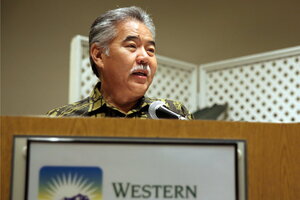Can Hawaii protect its endangered species without harming local business?
Hawaii, the 'endangered species capital of the world,' wants to protect its threatened plants and animals without harming local businesses.

Hawaii Gov. David Ige speaks at workshop held by the non-partisan Western Governor's Association in Honolulu, addressing Wyoming Gov. Matt Mead's Species Conservation and Endangered Species Act Initiative. Ige was joined by officials from the Hawaii Board of Land and Natural Resources, California Natural Resources Agency, National Oceanic and Atmospheric Administration and the U.S. Fish and Wildlife Service to talk about how to better protect endangered plants and animals.
Marina Riker/AP
Hawaii has a unique ecosystem and over 10,000 endemic species and now its own endangered species conference, too.
Hosted by Hawaii Gov. David Ige, the two-day conference of the nonpartisan Western Governors' Association is examining issues that affect endangered species, including invasive species and climate change.
“This workshop itself really does make sense to be hosted in Hawaii,” said Governor Ige. “We have more endangered species here in our islands than any other state in the country."
Hawaii is home to over 10,000 species found nowhere else on earth, according to the Hawaii Department of Land and Natural Resources –threatened by invasive species, habit changes, and climate change.
The chain of islands that make up Hawaii account for less than 0.2 percent of US land and more than 44 percent of the endangered species in the country. More than 100 plant taxa have already gone extinct, and another 366 Hawaiian plants are listed as endangered or threatened, according to the Native Ecosystem and Protection Management, earning Hawaii the title of “endangered species capital of the world.”
Hawaii and the other western states in the Association are looking for ways to protect endangered species without harming local business.
One challenge many of these states share is their dependence on tourism for state revenue – even as the tourism industry is threatening local ecosystems.
In 2015, Hawaii received 8.6 million visitors who contributed roughly $15.3 billion in revenue, a 2.3 percent increase from the previous year. The industry employs about 641,400 people, according to the state’s Department of Business, Economic Development & Tourism.
Ige says he sees a path forward, saying that certain measures may be able protect the species without costing the tourism industry
“I think it would be more beneficial to protection of species if we could focus our efforts rather than paint a broad brush area that is so enormous that active management is very, very difficult,” Mr. Ige said.
Speakers at the conference include officials from the Hawaii Board of Land and Natural Resources, California Natural Resources Agency, the National Oceanic and Atmospheric Administration, and the US Fish and Wildlife Service.
This is the last of four similar conferences held across the country, part of an initiative driven by Wyoming Gov. Matt Mead.
This report uses information from the Associated Press.

